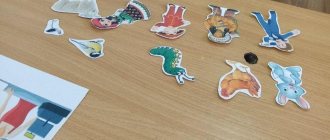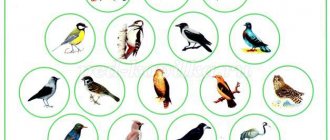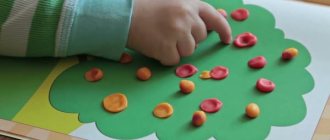Card index of didactic games card index of the world around us (senior group) on the topic
Card index of didactic games
"What is good and what is bad".
Goals: To teach children to distinguish good behavior from bad; Pay attention to the fact that good behavior brings joy and health to both yourself and the people around you, and, conversely, bad behavior can lead to unhappiness and illness.
Demonstration material: Excerpts from their works of art, life facts about the good and bad behavior of a person, children, or group.
Progress of the game: Children use facial expressions and gestures to express their attitude towards good and bad behavior (bad behavior - make an angry face, shake a finger; good behavior - smile, nod their heads approvingly). Answer the teacher's questions.
Sample questions: Today Seryozha ate snow again. Guys, is this good or bad? Children show with facial expressions and gestures that this is bad.
What could happen to Seryozha? The children answer.
"Noble Deeds"
Goal: To cultivate in children the desire to do things for the sake of other people. To form an understanding that we call an action not only heroism, but also any good deed for the sake of another person.
Material: ball
Progress of the game: Children are asked to list noble deeds towards girls (women) and boys (men). The teacher throws the ball into the hands of one of the players, he names a noble deed and throws the ball to the next player at his request.
For example, noble deeds for boys: call a girl only by her name; when meeting a girl, say hello first; give up your seat in transport; never offend a girl; protect the girl; help the girl carry heavy things; when a girl gets out of the transport, you need to get out first and give her your hand; the boy must help the girl get dressed, give her a coat, etc.
Noble deeds for girls: call a boy by name only; when meeting a boy, say hello; praise the boy for showing attention; do not offend or call the boy names, especially in the presence of other children; thank the boy for his good deeds and deeds; etc.
"Bag of Bad Deeds"
Progress of the game: Children receive black paper blots, the teacher offers to put them in a bag, and tell them what bad things he did today, as well as put negative emotions in this bag: anger, resentment, sadness. And when the children go for a walk, this bag is thrown away.
"Flower of Good Deeds"
Material: flower made of multi-colored cardboard, the petals are removable and inserted into the middle.
Progress of the game: You can play the game individually with a child, or with a group of children. Children are invited to collect the “Flower of Good Deeds”; for this, each child needs to take a petal and say some good deeds. Children list positive actions one by one, and the adult connects the petals to the middle. When the flower is collected, the children applaud each other.
“How do I help at home?”
Objectives: To form ideas about the household responsibilities of women and men, girls and boys. Cultivate a desire to help people.
Material: flower made of multi-colored cardboard, petals are removable, inserted into the middle
Progress of the game: Children take turns tearing petals from a flower, naming the duties they perform in the family (watering flowers, sweeping the floor, caring for animals, “raising” younger sisters and brothers, repairing toys, etc.). You can diversify the game. Let the children list the responsibilities that their mothers and then their fathers perform in the family.
"Let's compliment each other"
Goals: To teach children to be attentive to each other, to be able to show sympathy for children of the same and opposite sex. To consolidate knowledge about the qualities of masculinity and femininity.
Material: Any flower (it is better if it is not artificial, but live).
Progress of the game: The teacher brings a “Magic Flower” that will help the children express their feelings. Children are encouraged to pass the flower to any child and compliment them. If someone is ignored, the teacher pays a compliment to these children.
"Wishes"
Goals: To teach children to be attentive to each other, to be able to show sympathy for children of the same and opposite sex. To consolidate knowledge about the qualities of masculinity and femininity.
Material: heart toy (any toy)
How to play: Children stand in a circle. Passing a toy to each other, they say their wishes: “I wish you...”
Educational games for preschool children 4-7 years old
Author's games "Child and other people"
Description: I bring to your attention games from my work experience. The material is intended for preschoolers of the middle, senior, and preparatory groups. This material may be of interest to preschool teachers and parents. Goal: organizing extracurricular activities for preschool children Objectives: Develop observation, intelligence, imagination, Expand children's horizons, Help enrich speech, replenish vocabulary, Encourage children to learn and think. Every teacher has interesting games in their collection that use riddles and surprises, which have helped me out more than once. In this material I want to talk about the games that I use in my work from year to year. Perhaps some of them will interest you. Game “My Family” On a table or carpet, the teacher lays out a circle of thick cardboard, along the edge of which pre-prepared photographs of the players’ families are attached; in the middle of the circle there is a rotating arrow. Children choose a driver using a rhyme. He rotates the arrow, and when it stops near a photograph, he says: “Arrow, show us your family and tell us about it.” A child who recognizes his family talks about it. He becomes the next driver. Game - improvisation “Evaluate the action” One of the children is asked to show some action in relation to the other: give something, take away a toy, etc. The rest of the children evaluate the action. Game “Bag of Ideas” A symbol of a positive or negative emotion (correct or incorrect behavior) is attached to the bag. The teacher hands out plot pictures to the children and offers to put a drawing corresponding to the symbol in the bag of ideas. Each child must explain the correct choice of the picture. Children can help each other and get a chip out of it. Game "What color is your hair?" Dolls with different hair colors come to visit children (Snow Maiden - with white, Baba Yaga - with black, Clown - with red, Malvina with blue, etc.). Children name the hair color of each doll. The teacher asks you to think and name fairy-tale characters who have the same hair color as the Snow Maiden (Malvina, the clown, etc.). Game “Who will bring the picture faster?” On the table there are pictures depicting various clothes, shoes, and hats. Teacher: Fingers, palm, elbow are... Children determine that this is a hand and choose the desired item of clothing. The forehead, nose, eyes, ears, hair are on…. Children say that they are on the head, and also choose the desired object (headdress). Game “Sounds of the World” Children sit on chairs with their eyes closed, listen to an audio recording of various sounds (thunder, a rough and gentle voice, the sound of rain, the sound of a car, birds singing - joy, etc.). Game “Good - Bad” Children are offered a set of plot pictures that depict good and bad actions of people. The children evaluate these actions. Game “Mysterious Pictures” Mysterious images of aliens are displayed on a set of canvases. Children determine how these little men differ from people.
We recommend watching:
Didactic game for children from 1 to 5 years old “Family Hobbies” Do-it-yourself outdoor game “Fishing” for kindergarten Master class. Making rings for juggling Musical and rhythmic games for preschool children
Similar articles:
Games in kindergarten for children from 3 to 5 years old
Educational game in the preparatory group of kindergarten
Ball games for children 5-6 years old at home with parents
Didactic game “Bad or Good”
Irina Tartabaeva
Didactic game “Bad or Good”
educational game
«Bad or Good»
Didactic game " Good or bad "
- an activity for preschoolers.
In a playful way, the teacher instills moral standards in the students. Children learn to distinguish good deeds from bad , and the rules of behavior in certain life situations are fixed in their memory.
The game can be played by children of junior and senior preschool age.
The purpose of the didactic game is to develop an understanding of which actions are good and which are wrong, how to behave correctly in different life situations, and how to determine the correctness of other people’s actions.
Tasks:
• Teach children to distinguish good behavior from bad ;
• To promote the accumulation of experience in children of friendly relationships with people around them and nature;
• Foster a negative attitude towards rudeness and greed;
• Cultivate an attentive attitude and love for people and the world around them;
• Develop the ability to collaborate.
The game material consists of petal cards depicting various situations, as well as circles in the form of two emoticons (sad and happy, circles of two colors (red and green)
by the number of participants in the game.
Preliminary work: Conversations on the topic: “Good and bad deeds ”
,
“What you can do and what you can’t do”
.
Option 1.
Children divide the petal pictures into two groups, into good and bad deeds, and attach them to the corresponding emoticon.
Children explain why they put a petal on this flower
Option 2.
The task can be made more complicated: Children divide the petal pictures into two groups, into good and bad deeds and attach them to the corresponding emoticon, explain why they put this flower on it.
For each illustration depicting incorrect behavior, there is a picture with a similar situation where the character does the right thing.
Children are looking for a similar situation: a bad and a good deed
Option 3.
Can be used for classes in the senior dosh. WHO. For the lesson, you need to prepare green and red circles (one red and green circle for each child)
.
The green circle means "
good " , the red circle
"
bad " . The teacher shows and reads out the situation, and the children raise one of the circles depending on the situation.
For example: “A child draws on wallpaper - is it good or bad ?”
Children raise a red circle.
This is how the flower of good deeds .
Word game "Good and bad"
1. Develop children's speech, imagination and creative imagination.
2. Teach children to understand moral situations.
Educator:
Guys, now prepare the colored circles. I will read excerpts from literary works familiar to you, and you will determine whether the heroes act well or badly. If you think it is good, then show a yellow circle, if it is bad, show a blue one.
- “Kolobok, Kolobok, I’ll eat you!” (blue)
- “Masha walked and walked through the forest - tree after tree, bush after bush, and got lost!” (blue)
- “The animals built a mansion better than the previous one and began to all live together in it” (yellow)
- “The beaten one is not lucky, the beaten one is not lucky!” (blue)
- “Grandfather planted a turnip, the turnip grew big - very big!” (yellow)
- “The fox got into the habit of dragging chickens into the hen house...” (blue)
— “Cinderella was a kind, hardworking girl.” (yellow)
- “All winter Thumbelina looked after a sick swallow.” (yellow)
__“I carry the scythe on my shoulders, I want to kill the Fox. Go away, Fox, out!” (yellow)
__ “Don’t cry, grandfather! Don't cry grandma! I will lay you an egg that is not golden,
and simple! (yellow)
Educator:
Guys, what actions do you want to do more? Let's now come up with a story about how you did a good deed. Now we will listen to only two stories from those children who are the first to raise their hands. (We listen to the children’s stories) And the rest will tell their parents at home.
Guys, what did you like about our game?
Consultation for parents
"What is tolerance"
"What is tolerance"
There are millions of people in the world. They are different. They have different genders, different ages, different social status, different appearance, different rights, different races, different nationalities. We are different, but we all live on one planet - Earth. Every day we come across a lot of people who are not like us, they are not like us, they are different. But we need these people for the further development of the world, for life on Earth. We must accept their individuality, respect their rights, listen to their opinions. A man must respect a woman, and a woman must respect a man, an adult must respect a child, and a child must respect an adult, a physically and mentally healthy person must respect a sick person, a representative of one nationality must respect a representative of another nationality.
Many nationalities, cultures, traditions and rituals have developed on our territory. Each national culture is unique, each carries something special that is not like the others. Living in conditions of ethnic diversity is one of the sources of serious problems for any society where children grow up. In a world where the interpenetration of different cultures is on an ever-increasing scale, teaching the values and skills of “living together” has become a primary task of education. But our children live in this century. Do we really want them to live in constant hostility and misunderstanding? Do we really want people to die every day due to ethnic conflicts? Don’t we really want the peace that we glorify in our poems and songs? How to come to peace, how to establish peace throughout the entire Earth? To do this you need:
- educate and teach children to be open, treat other peoples, their history and culture with understanding, teach them the basics of human coexistence;
- teach how important it is to renounce violence and seek peaceful ways to resolve disputes and conflicts;
— to cultivate altruism, openness and respect for others in children, to instill in them the ability to understand others, while maintaining their individuality. All of these qualities are based on self-esteem and the ability to recognize the cultural diversity that exists in the modern world.
Constant regional conflicts and explosions of hostility between peoples led to the disintegration of countries and serious changes in the political map of the world, which had previously existed without changes for about half a century. A wave of gang warfare, religious hostility and ethnic conflicts swept across the world. Various communities were plunged into war. Now resolving disputes, reconciling warring parties and restoring social life has become one of the most difficult processes that human society has ever attempted. In this situation, teachers at all levels of the education system are faced with a serious problem: how to teach the younger generation to live in the modern world, avoiding conflicts, and treating all members of society with respect. Conflicts, exacerbated by poverty, have increased the pace of migration, increasing the number of refugees seeking shelter and migrants seeking work in what were once predominantly monocultural countries and regions. During these processes, multiculturalism usually emerges imperceptibly, which becomes a significant factor in both social life and preschool and school education. Children's groups become a microcosm of cultural diversity. Under these conditions, the main requirement for maintaining a healthy atmosphere in schools and preschool institutions has become the requirement for mutual understanding between people of different cultures. For many, new circumstances became the source of complex problems and were a prerequisite for the development of dialogue between cultures. Intercultural understanding must be taught. Reconciliation must be taught. Consequently, the issue of teaching TOLERANCE becomes relevant and is an integral component of human rights. In its simplest and most basic form, TOLERANCE IS THE RECOGNITION OF OTHERS' RIGHT TO RESPECT FOR THEIR PERSONALITY AND SELF-IDENTITY (Betty Reardon). Interethnic tolerance is a tolerant, accepting, respectful, understanding attitude both towards one’s own national and ethnic culture, and towards the culture of other nations and ethnic groups. “We are doomed to tolerance” - this is exactly what the principle of morality tells us. Introducing a child to folk culture forms the basis of his national identification, the formation of a sense of national pride and self-sufficiency, and the formation of interethnic tolerance. “Love your neighbor as yourself,” says the Holy Scripture. In order to accept and understand another, another national culture, it is necessary to initially become familiar with the origins of one’s own, to realize its spiritual richness and unconditional social value. The modern world is cruel. Children also became cruel. And the norm of life for every person - adult and child - should be TOLERANCE. What is this mysterious tolerance?
Tolerance can be defined as a tolerant attitude towards other people, regardless of their ethnic, religious or cultural background, a tolerant attitude towards other views, morals, and habits. Tolerance is manifested in the desire to achieve mutual respect, understanding and agreement between different points of view without the use of violence. But being tolerant does not mean being indifferent to other people. Tolerance presupposes reciprocity and active participation of all interested parties.
It is important to note that understanding and acceptance of the “other” is directly related to a tolerant attitude towards oneself. A tolerant person has self-esteem, has his own values and beliefs and, at the same time, respects the beliefs of other people. For example, it is impossible to treat others kindly if you have a negative attitude towards yourself.
Becoming a more tolerant person means learning to respectfully listen to any point of view, and stop dividing the world into two camps: “us” and “them.” You just need to learn to defend your beliefs without using violence, and find more constructive methods for resolving disagreements. Sometimes it is enough to simply listen and, most importantly, hear the other person so that he, in turn, listens to your opinion.
Of course, it is not at all easy to learn to live with different people, but this is one of the real opportunities to reduce the number of conflicts around us. To do this, you just need to look around you, admire the diversity of the world and people around you and do not forget that the preservation of this diversity depends on the respectful and tolerant attitude of each of us!
Consultation for parents “How to love your child”
“Mommy, I love you so much,” the son says to his mother. - Oh, I love you too - very much. Any mother dreams of hearing these words. Loving your child is a kind of art and literally a daily work that requires some effort. Love is affection, it is understanding, it is the perception of your child as he is. Listen to the words: “I love.” You feel warmth, tenderness, a surge of strength and energy. A child needs to be loved and understood. He needs your love and care.
What does it mean to love your child? Love in general is very individual in nature. The fact is that we are all different. We have different views on life and raising children. In most cases, parents, namely mothers and fathers, intuitively use the parental programs of their parents installed in their subconscious. It happens, of course, the other way around: “I was forbidden a lot as a child, but I will allow everything for my child” or: “My parents spoiled me a lot with their children as a child, I will be very strict.” Don't forget about the child. We must create conditions that would favorably influence the development of your child. It is necessary to adhere to the basic principles in raising your child: - pay as much attention as possible to your child; — communicate with your child as an equal, as with an adult (they love it); - do not forget to encourage your child, praise him, even for the smallest victories; - and, most importantly, believe in your child, give him self-confidence and everything will definitely be fine with you.
There are no good or bad parents, but the end result is their children. All children are different. They have different interests, inclinations, abilities, characters. But they are united by a common moral foundation - they are all children. And, sometimes we adults just need to transform into the role of a child. And, look at any situation through the eyes of a child.
- Why am I forbidden to run through puddles? After all, it’s a lot of fun... True, it’s fun, but the fun can end in illness, drugs and everything like that. But it's fun... right? A kind (is it kind?) mother will allow you to run through puddles or simply not pay attention. An angry mother will scold you and leave you at home. And then a third mother appears on the horizon. She will not swear, she will not scream or stomp her feet. She will sit next to the child and hug him tenderly. Quietly he will say that walking in the rain is fun, but you can’t do it, otherwise you might get sick. The child pays attention to the timbre of the mother’s voice, intonation. She speaks calmly, affectionately and at the same time confidently and persistently. And, she achieves the desired result: the child agrees with her. There is nothing complicated here, the main thing is to believe in the result.
Loving children is an art, this is the most important goal, in achieving which there are many obstacles, many mistakes and blunders, and yet the expected victory certainly awaits us. After all, they really say:
“Happy children are the most beloved children.”






